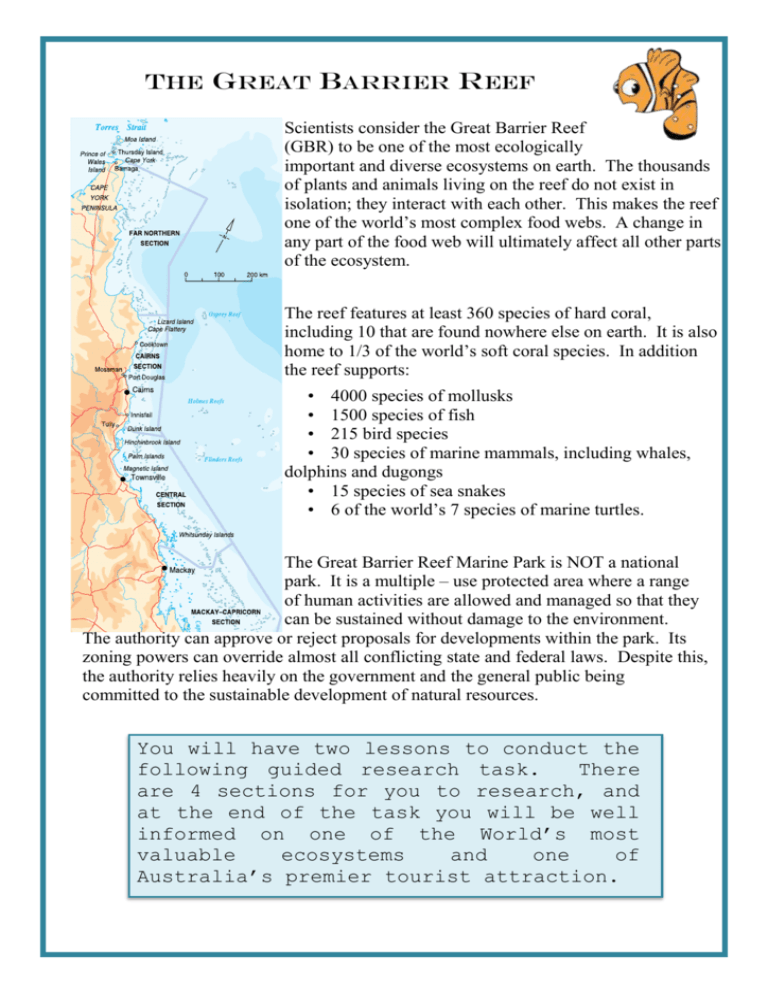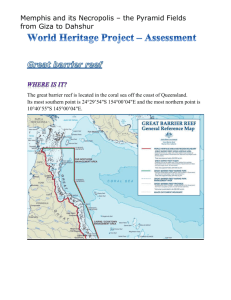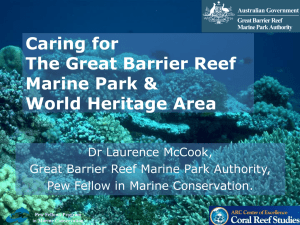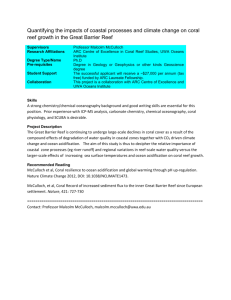Coral Reefs Research Task
advertisement

The Great Barrier Reef Scientists consider the Great Barrier Reef (GBR) to be one of the most ecologically important and diverse ecosystems on earth. The thousands of plants and animals living on the reef do not exist in isolation; they interact with each other. This makes the reef one of the world’s most complex food webs. A change in any part of the food web will ultimately affect all other parts of the ecosystem. The reef features at least 360 species of hard coral, including 10 that are found nowhere else on earth. It is also home to 1/3 of the world’s soft coral species. In addition the reef supports: • 4000 species of mollusks • 1500 species of fish • 215 bird species • 30 species of marine mammals, including whales, dolphins and dugongs • 15 species of sea snakes • 6 of the world’s 7 species of marine turtles. The Great Barrier Reef Marine Park is NOT a national park. It is a multiple – use protected area where a range of human activities are allowed and managed so that they can be sustained without damage to the environment. The authority can approve or reject proposals for developments within the park. Its zoning powers can override almost all conflicting state and federal laws. Despite this, the authority relies heavily on the government and the general public being committed to the sustainable development of natural resources. You will have two lessons to conduct the following guided research task. There are 4 sections for you to research, and at the end of the task you will be well informed on one of the World’s most valuable ecosystems and one of Australia’s premier tourist attraction. To start your Research Task 1. Why is the Great Barrier Reef such an important part of the physical environment? 2. Outline the task of the Great Barrier Reef Marine Park Authority. 3. Go online to discover a list of activities that are banned in the GBR Marine Park. 4. The Great Barrier Reef Marine Park is divided into a number of zones that outline the activities, which are permitted in different sections of the park; go online to discover the purpose of these zones. 5. The diagram below illustrates the threats to the environment that the authority must constantly manage in order to ensure the Coral Reef’s sustainability. Which of these threats do you believe poses the greatest detrimental impact to the Great Barrier Reef? Explain your response. Managing the Great Barrier Reef Access the Great Barrier Reef Marine Park Authority’s website and complete the following tasks. Access the Critical Issues: Conservation, Biodiversity and World Heritage section of the site and complete the following tasks: Outline the natural and cultural values for which the Great Barrier Reef is famous. Outline the authority’s responsibility under the World Heritage Convention. What do the terms ‘critically endangered’, ‘endangered’ and ‘vulnerable’ mean in relation to threatened species? How many species are threatened on the Great Barrier Reef? Name three of these species. Select ONE of these threatened species and utilize the software ‘Pages’ to prepare a poster that will educate tourists at the Park of it’s risky future. The poster should include:• Name of the endangered species • Habitat of the species • Human activities that pose a threat to the species • Actions we can take to protect the species. • Use images and short, pointed sentances to communicate effectively with the tourists. Stakeholder conflict Stakeholders are those individuals and groups of people who have an interest in a situation or issue. There are many different groups of people that are interested in the use of and access to the Great Barrier Reef. Tourists, tourist operators, fishermen and boat operators are the obvious stakeholders to the Great Barrier Reef. However, there are many more interested parties. The government of Australia has a responsibility to manage the reef ecosystem effectively, the World Heritage Organisation has determined the reef to be of global importance, and over 40 000 years ago the aboriginal people began a spiritual and cultural connection with the region. The underlying reason for the management and sustainability of the Coral Reef ecosystem is to ensure their continued survival for the future generations. With so many stakeholders that are interested in the management of the Great Barrier Reef, there is bound to be conflict. Divide the statements displayed in the diagram above, into those that are pro- conservation, those that are pro-development and those that seek a balance between the conflicting demands placed on the resources of the reef ecosystem. Pro-conservation Pro-development Balance In Conclusion The partnership between the Great Barrier Reef Marine Park Authority and the various communities and interest groups of coastal Queensland is an excellent example of what can be achieved when governments and local communities work cooperatively to promote sustainable development. But more help is needed, and it is up to the geographers of the world to inspire others. Consider that you have just been appointed as Head of the Great Barrier Reef Marine Park Authority. Of all the various stakeholders in the Great Barrier Reef, to whom do you feel you owe the greatest duty? Why? In your newly appointed position as head of the GBRMPA write a letter to the editor of the Sydney Morning Herald imploring the Australian public to help protect the Great Barrier Reef for future generations. In your letter you should address the following:• Why the Reef is so special. • Why the Reef needs protection. • How every Australian can assist in saving the Reef. • Provide an emotional appeal on behalf of some of the threatened animals. • And include your favourite snapshot of the Great Barrier Reef. Klemman et al (2010) Global Explorations Stage 4. Heinemann: Melbourne. p242-245







